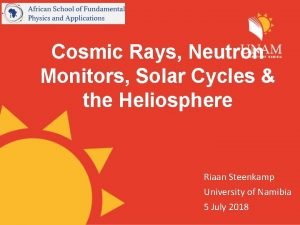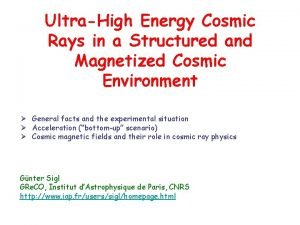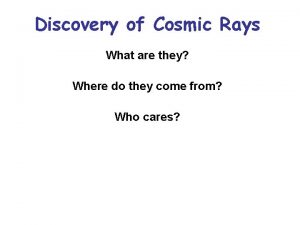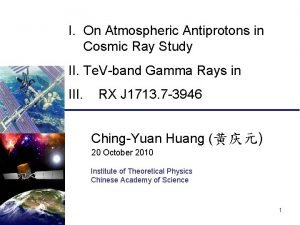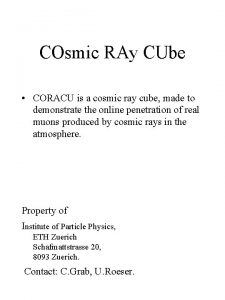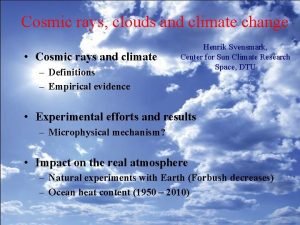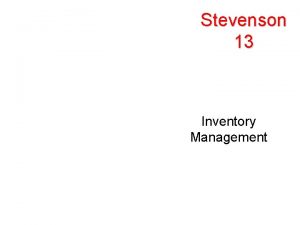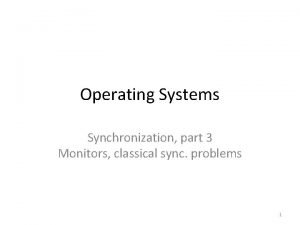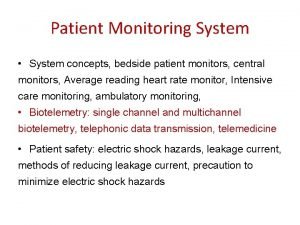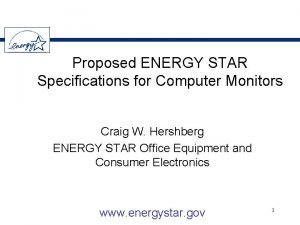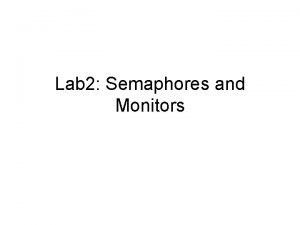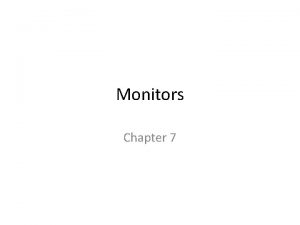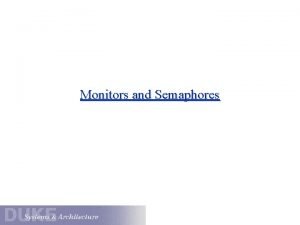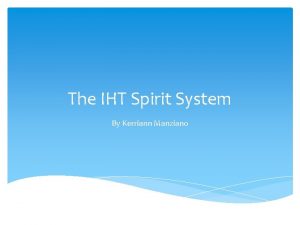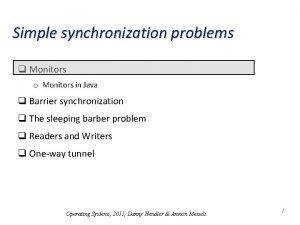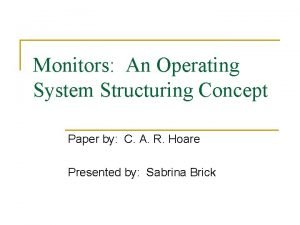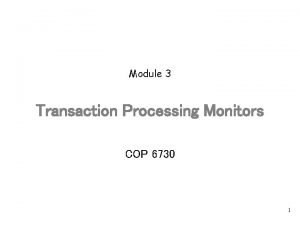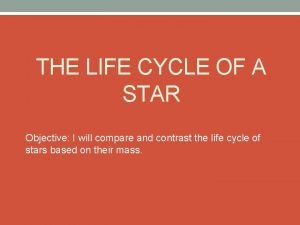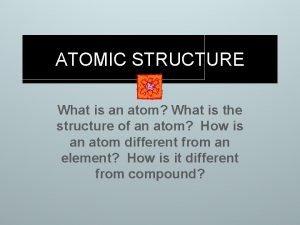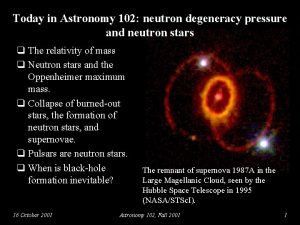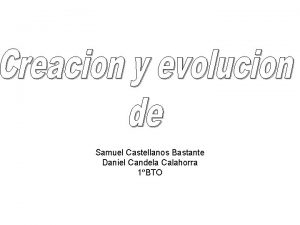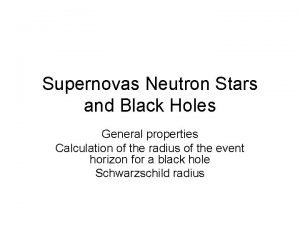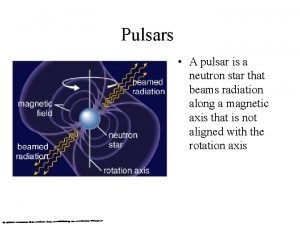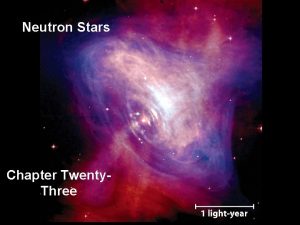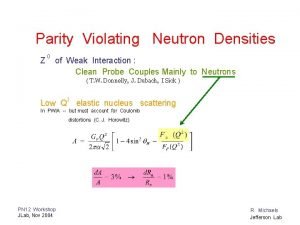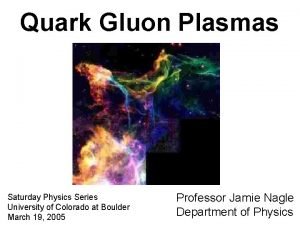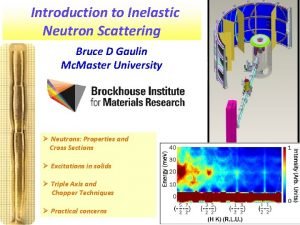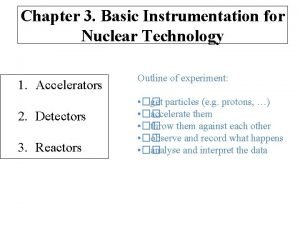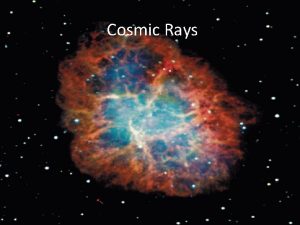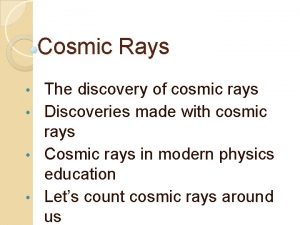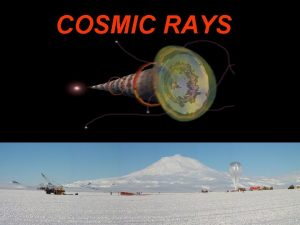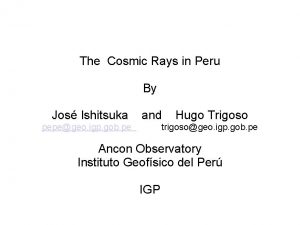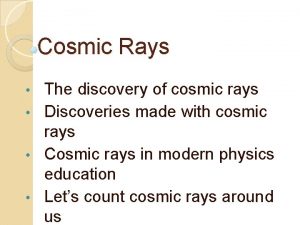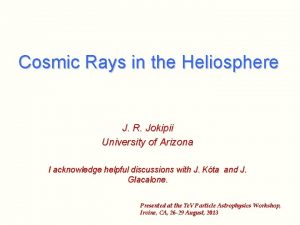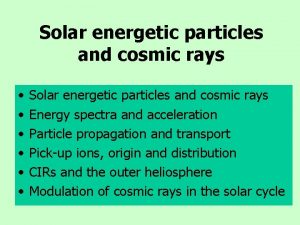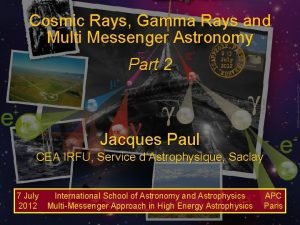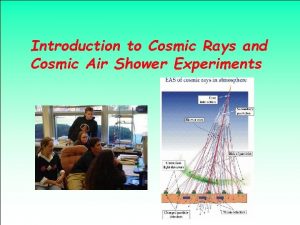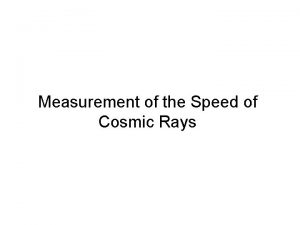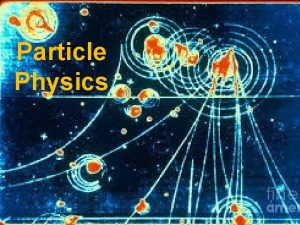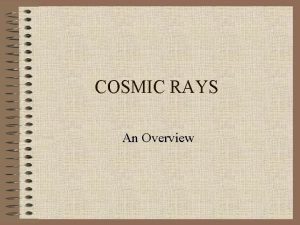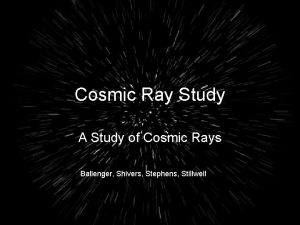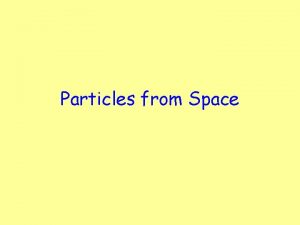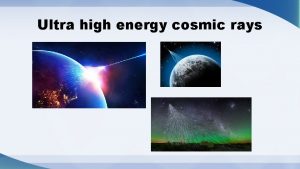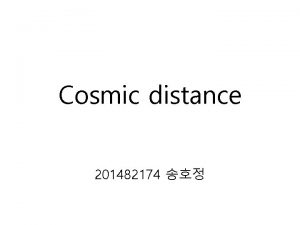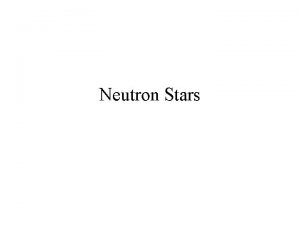Cosmic Rays Neutron Monitors Solar Cycles the Heliosphere








































- Slides: 40

Cosmic Rays, Neutron Monitors, Solar Cycles & the Heliosphere Riaan Steenkamp University of Namibia 5 July 2018

History and Discovery A short history of the discovery of Cosmic Rays

At beginning of 20 th Century: • Hypothesis: Natural radioactivity caused by decay of isotopes in crust of Earth • Test(s): Taking instruments up towers to measure ionisation rate • Inconclusive due to limited height • Q: How to increase height? • A: Balloon flights!

Victor F. Hess • Balloon flights up to 5. 3 km with improved instrumentation in 1911— 13 • Results: • • • Radiation levels decreased up to 1 km Thereafter increased sharply until radiation levels at 5 km were twice that at sea level Conclusion: Radiation from outer space Millikan named them “Cosmic Rays” (ionising rays from the cosmos) Hess shared Nobel prize for discovery with Carl David Anderson

Cosmic Rays (CR) • Misnomer: Not rays, but charged particles • Measured atmospheric radioactivity not actually caused by CR, but by secondary particles produced by CR interactions in upper atmosphere

Air showers • CR interacts with air molecule • Produces a cascade of elementary particles • Electromagnetic shower • Hadron cascade • Focus on latter, esp. the energetic neutrons as means of detecting CR

Neutron Monitors Instruments to measure high-energy particles impacting the Earth from space

Basic design (Invented by John A. Simpson in 1948)

Mini-Neutron Monitors

Neutron Monitor Arrays

How it works • Reflector: • outer shell of proton-rich material to stop low energy neutrons from outside (paraffin/polyethylene) • Producer: • fast neutrons that get through reflector interact with dense material to produce more lower energy neutrons (lead) • Moderator: • Proton-rich material slows down secondary neutrons to increase likelihood of detection • Proportional Counter: • neutrons interact with gas nuclei causing nuclear reactions that in turn causes energetic charged particles that ionise gas producing electrical signal (n+10 B +7 Li or n+3 He 3 H+p)

Where to find them? Potchefstroom (SA), Hermanus (SA), SANAE (Antarctica), Tsumeb (Namibia), etc SANAE 04 Tsumeb Pieter Stoker

Need many NM arrays • To measure Anisotropy: • View different directions in space – anisotropy determined • Diurnal variations • To measure Energy Spectrum • Geomagnetic field screens off charged cosmic-ray particles more strongly in equatorial regions than, e. g. , polar regions • Only higher energetic CR can easily penetrate across Bfield lines, while lower energy particles are screened off. • In polar regions even relatively low energy CR can penetrate deep into atmosphere

Energy dependence

What it Measures NM Data interpretation: • Measures mainly Galactic cosmic rays: • Solar Cycle – “solar modulation” (11 & 22 year cycles) • Forbush Decreases – decrease in intensity after solar flare (named after Scott E. Forbush) • Ground level enhancements – a few times a decade Sun emits (relatively) high-energy solar particles that can be detected at ground level

Heliospheric Physics Interpretation of clues to Heliospheric Physics from neutron monitor data and beyond

11 -year sunspot cycle Solar maximum – sunspot number peaks Solar minimum – almost no sunspots

Evidence of 27 -day rotation

The Sun’s outer layers

Coronal Mass Ejections (CMEs)

The Solar Wind • Outflow of hot plasma at “supersonic” speed • “supersonic”: faster than propagation small amplitude of ion-acoustic waves propagating in plasma • About 400 km/s on average around solar minimum

Faraday rotation • A magneto-optical interaction: • rotation of plane of polarisation proportional to component of B-field in direction of propagation • Can be used to determine B -field polarity from polarisation state of light propagation parallel to field lines

Salient Properties of Plasmas • Plasma is the 4 th state of matter, i. e, a quasi-neutral ionised gas with collective behaviour • Can be modelled as a two interpenetrating fluids: an ion-fluid an electron-fluid. • Property: due to extreme mobility of the electron fluid, a high quality plasma is a superconductor. • If a B-field is present in a plasma, relative motion will induce extreme currents in the plasma and nature will, of course, preclude that with the consequence that B-fields can be “frozen” into a plasma with very little relative motion. • Thus, if a plasma is flowing, it will “drag” magnetic field lines with it. • All sorts of waves can propagation through plasmas: electron-, ion acoustic-, electromagnetic-, magnetosonic-, hydromagnetic waves (a. k. a. Alfvèn waves), etc

Electromagnetic waves propagating through plasmas • • with

Clues: 1. Anti-correlation of cosmic-ray and sunspot cycle 2. Cosmic-ray variation has “sharpish” peak followed by “bluntish” peak 3. 11 -year sunspot cycle with suggestion of 22 -year sunspot cycle

Conclusions from Clues • What neutron monitors measure actually energetic CR of Galactic origin and not of Solar origin. • Modulation by solar wind: • At solar maximum, solar wind is stronger and more variable and it opposes Galactic CR from coming close to the Sun • At solar minimum the weaker and more even solar wind allows more Galactic CR to be measured • There are two different types of solar minima • Forbush decreases occur in correlation with CMEs that temporary reduce Galactic CR by effectively “blowing” some away. • Polarisation observations of Sun reveal chaotic polarity at solar maximum and opposite polarity states between 2 consecutive solar minima, i. e. , at every solar maximum there is a complete magnetic reversal! • PHYSICISTS NEEDED EXPLANATION(S): • What is the physical system like? • A mathematical model is needed.

Magnetic Mirroring and Scattering Centres Ability of a magnetic field with a gradient in field strength to mirror charged particles

How it works •

The IMF and the Heliospere The Interplanetary Magnetic Field and the structure of the Heliosphere

The Parker Spiral Field (named after Eugene N. Parker) • Supersonic SW, IMF, TPE Mercury 21 35 Earth 45 7 Mars 56 4 Jupiter 80 1 Neptune 88 0. 2

Parker Spiral Field (math) •

The Neutral Sheet a. k. a. Current Sheet •

The Wavy Neutral Sheet If the magnetic equator is at an angle with the rotational equator, the neutral sheet will be take the shape as shown

Particle drifts in the IMF •

How to create a mathematical model? • The magnetic scattering centres cause pitch-angle scattering of CR along field lines with much lower probability of cross-field migration. This is not unlike the process of diffusion. • The solar wind dragging the field lines with its scattering centres provides not only a mechanism for a tendency of convection/advection of CR, but also provides and energy loss mechanism for CR due to adiabatic cooling. • Thus, an energy dependent convection-diffusion model can be derived (my next lecture)

The SWTS and Outer Heliosphere The Solar Wind Termination Shock, Heliopause, Heliosheath and Bow Shock

The SWTS and Heliosheath • At solar minima the smooth outflow of supersonic solar wind plasma causes the formation of a stationary hydrodynamic shock. • From any treatise of fluids it follows that the only way for a supersonic flow to become subsonic is through a discontinuous transition, or rather, a shock. A plasma that sometimes behaves like a magnetised fluid is no different. • In addition the flow of interstellar gas and plasma hitting the solar wind outflow and diverting it around our heliosphere causes a “sheath” and bow shock to form around the entire solar system, not unlike a bow shock of a boat.

Analogue: Experimental Evidence

Cartoon time To be continued…

Thank You
 Cosmic rays
Cosmic rays Cosmic rays
Cosmic rays Cosmic rays discoverer
Cosmic rays discoverer Cosmic waves
Cosmic waves Cosmic ray cube
Cosmic ray cube Svensmark
Svensmark Wholesale solar power panels
Wholesale solar power panels Solar energy is free. solar is inexhaustible
Solar energy is free. solar is inexhaustible Objectives of eoq
Objectives of eoq Citra two monitors
Citra two monitors Graphic monitor and workstation in computer graphics
Graphic monitor and workstation in computer graphics Sleeping barber problem using monitors
Sleeping barber problem using monitors Dining philosophers problem using monitors
Dining philosophers problem using monitors Bedside patient monitoring systems
Bedside patient monitoring systems Intervax vaccine
Intervax vaccine Energy star monitors
Energy star monitors Which organization monitors interstate fish shipments?
Which organization monitors interstate fish shipments? Semaphores and monitors
Semaphores and monitors Identifies, selects, monitors, and evaluates sales channels
Identifies, selects, monitors, and evaluates sales channels Limitations of semaphore
Limitations of semaphore Monitor condition variable
Monitor condition variable What are monitors and condition variables?
What are monitors and condition variables? Iht spirit system
Iht spirit system Sleeping barber problem using monitors
Sleeping barber problem using monitors Monitors: an operating system structuring concept
Monitors: an operating system structuring concept Food & beverage gas safety monitors
Food & beverage gas safety monitors Transaction processing monitors
Transaction processing monitors White dwarf neutron star black hole
White dwarf neutron star black hole Mass of neutron
Mass of neutron Neutron degeneracy
Neutron degeneracy Candela y neutron
Candela y neutron Neutron superhighway
Neutron superhighway How to calculate schwarzschild radius
How to calculate schwarzschild radius Neutron star
Neutron star Neutron star
Neutron star Parity of neutron
Parity of neutron Label an atom
Label an atom Proton neutron quarks
Proton neutron quarks Atomic mass number of nitrogen
Atomic mass number of nitrogen Neutron fission
Neutron fission Neutron life cycle
Neutron life cycle
